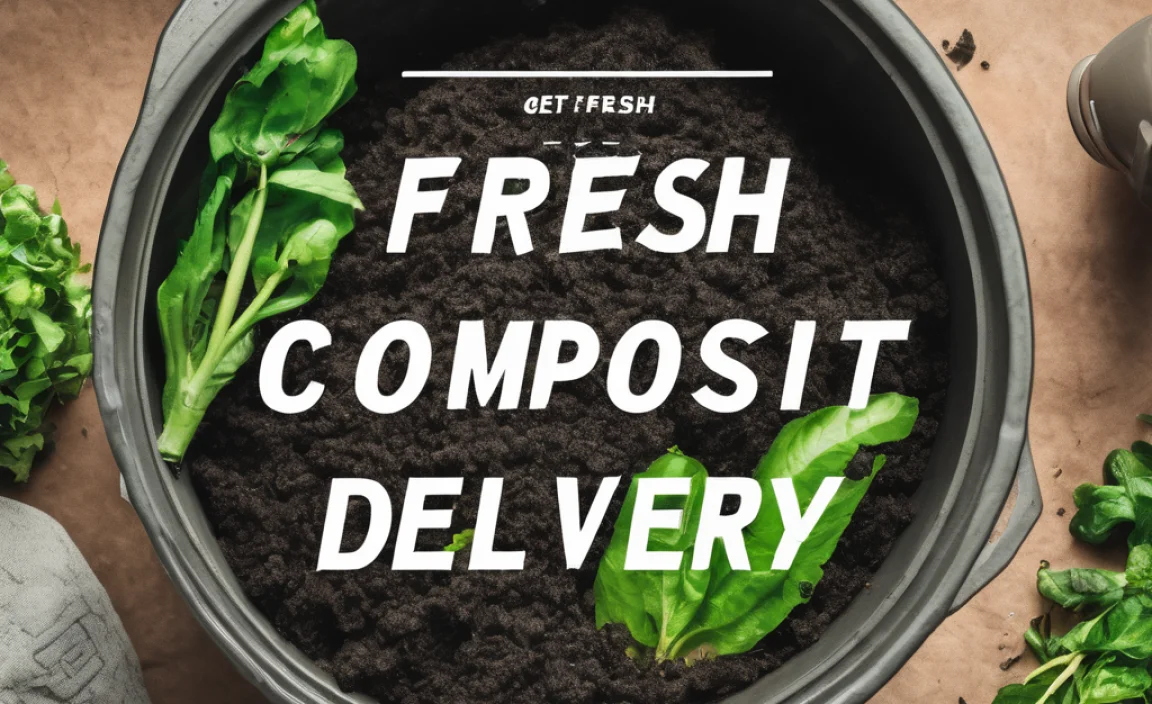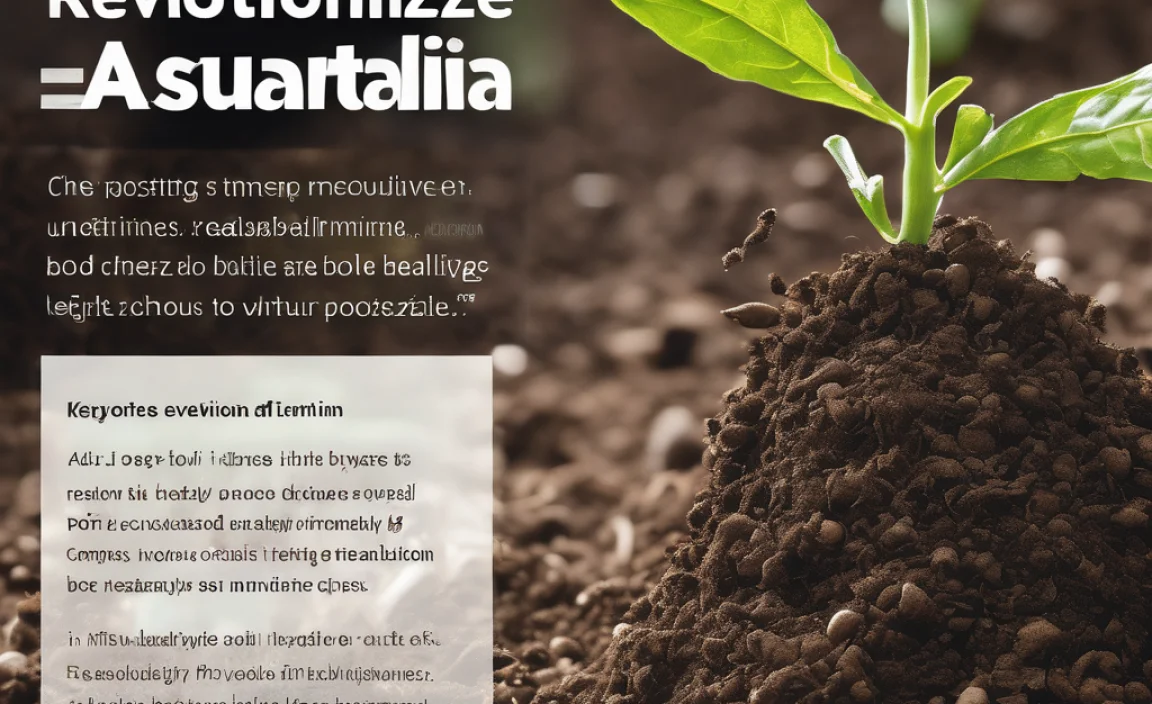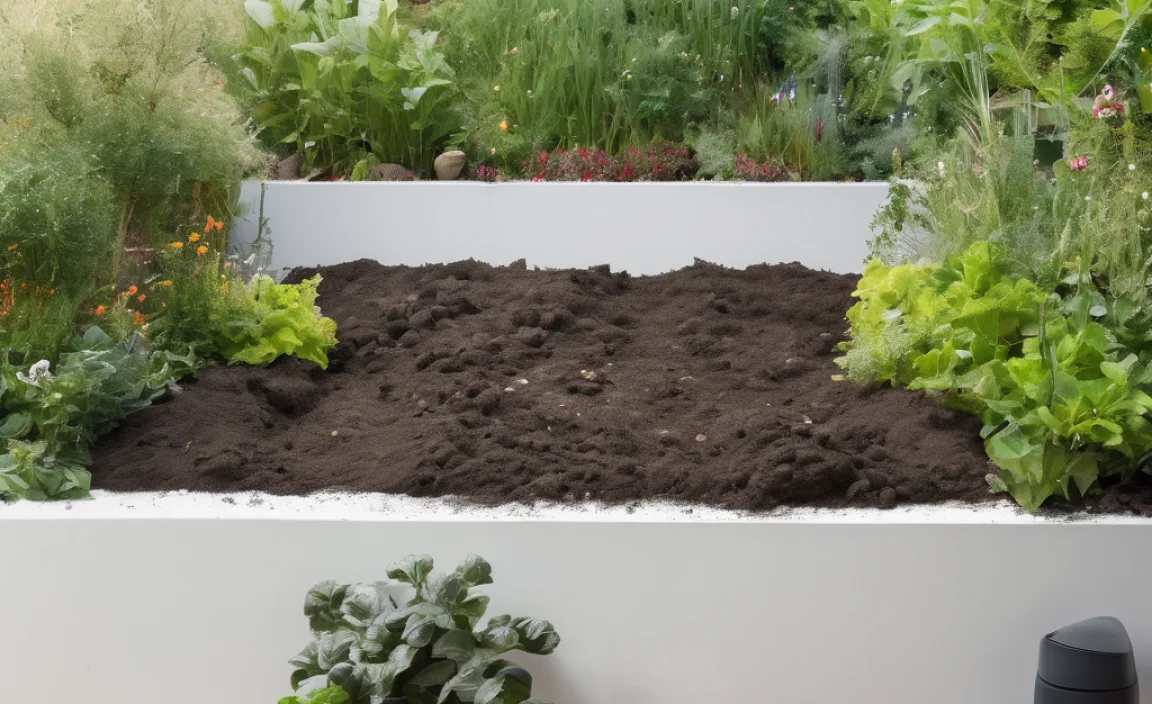Living in a city doesn’t mean you have to miss out on the magic of composting. It’s a fantastic way to reduce waste and create super plant food. But if you’re new to composting in a smaller space, you might be wondering about the “right” temperature.
Don’t worry, it’s not as complicated as it sounds! This guide will break it all down for you, making urban composting simple and effective. We’ll cover everything from choosing a bin to understanding the ideal composting conditions, ensuring your kitchen scraps turn into garden gold.
Composting for Urban Areas: Cracking the Temperature Code
Hey there, fellow urban dwellers! I’m Troy D Harn from TopChooser, and I’m here to help you conquer composting, even if you’re working with a bit less space. You’ve probably seen those amazing gardens or heard about how composting can turn your food scraps into nutrient-rich soil. It’s true, and it’s totally achievable, even in a city apartment or a small backyard.
One of the biggest questions beginners have is about temperature. “Does my compost pile need to be super hot?” “What if it’s too cold?” These are valid concerns, and the truth is, temperature plays a crucial role in how quickly and effectively your compost breaks down. But understanding it for urban composting isn’t about hitting specific, hard-to-reach degrees. It’s more about creating the right environment for those tiny microbes to do their amazing work.
We’ll walk through exactly what you need to know, making sure you feel confident every step of the way. Get ready to transform your kitchen waste into black gold for your potted plants or community garden plot!
Why Temperature Matters in Composting
Think of composting like baking a cake. You need the right ingredients and the right oven temperature for it to turn out perfectly. In composting, the “ingredients” are your greens (like fruit peels and coffee grounds) and browns (like shredded paper and dry leaves), and the “oven temperature” is regulated by the conditions inside your compost bin. Temperature is key because it directly affects the activity of the microorganisms that break down your organic matter.
Certain temperature ranges encourage different types of decomposers. For rapid, “hot” composting, you need temperatures high enough to kill weed seeds and pathogens. For slower, “cold” composting, lower temperatures are fine, but the process takes longer. For most urban composters, aiming for a happy medium is the goal, leading to efficient breakdown without too much fuss.
The Sweet Spot: Ideal Composting Temperatures
The magic happens with a mix of temperatures, and understanding these ranges can help you troubleshoot your compost bin.
Mesophilic Stage (The Warm-Up Act)
This is where composting often begins. Temperatures range from about 50°F to 100°F (10°C to 38°C). In this phase, a wide variety of bacteria, fungi, and other microorganisms are active. They start breaking down the readily available organic materials.
Thermophilic Stage (The Hot Stuff!)
This is the stage most people think of when they hear “hot composting.” Temperatures can soar between 130°F and 160°F (55°C to 70°C). This high heat is fantastic! It significantly speeds up decomposition and is effective at killing weed seeds and harmful pathogens. To reach and maintain these temperatures, you generally need a compost pile that’s at least 3 feet by 3 feet by 3 feet (1 cubic meter) and has a good balance of greens and browns, along with sufficient moisture and aeration.
Cooling Down and Curing
Once the thermophilic stage is complete, the compost pile begins to cool down. This is when a new set of organisms, including actinomycetes (a type of bacteria that creates that earthy compost smell), take over. They continue to break down tougher materials like woody bits. This curing phase is essential for producing stable, nutrient-rich compost.
For urban composting, especially in smaller bins, reaching consistent high thermophilic temperatures can be a challenge. Don’t be discouraged if your bin doesn’t get super hot! Even at cooler temperatures, decomposition will occur, it will just take longer. You’ll still end up with fantastic compost for your plants.
Factors Affecting Composting Temperature in Urban Areas
Several things can influence how warm your urban compost pile gets:
- Bin Size: Smaller bins simply don’t retain heat as well as larger piles. This is a common characteristic of urban composting setups, like tumblers or small enclosed bins.
- Insulation: The material of your bin and its surroundings can help or hinder heat retention. A black plastic bin might absorb more sun than a wooden one.
- Ambient Temperature: If it’s freezing outside, your compost bin will struggle to get warm. Similarly, a very hot summer day might dry out your compost too quickly if not managed properly.
- Material Balance: An imbalance of “greens” (nitrogen-rich) and “browns” (carbon-rich) can affect decomposition rate and, consequently, temperature. Too many browns mean a slow, cool process. Too many greens can lead to a slimy, smelly pile that doesn’t heat up well.
- Moisture Levels: Compost needs to be damp, like a wrung-out sponge. Too dry, and the microbes slow down. Too wet, and it can become anaerobic (lacking oxygen), leading to foul smells and poor decomposition.
- Aeration: The beneficial microbes need oxygen. Turning your compost regularly introduces fresh air, which is essential for their activity and for generating heat.
Urban Composting Methods and Their Temperature Characteristics
Different composting methods are suited for different urban living situations. Here’s a look at how temperature plays a role in each:
1. Tumbler Composters
These are popular for urban yards and balconies. They are enclosed drums that you can easily turn. Tumblers are great for mixing materials and introducing air. Because of their smaller size and often elevated position, they can have a harder time reaching and maintaining sustained high temperatures compared to a large, ground-based pile.
Temperature Focus: Aim for moderate warmth. Regular turning is key to aeration and helping the materials heat up as much as possible. They tend to work best in milder weather.
Pros: Neat, contained, easy to turn, faster than static bins (if managed well).
Cons: Limited capacity, can be harder to reach very high temperatures.
2. Small Contained Bins (e.g., plastic bins, DIY boxes)
These are often placed on patios, balconies, or small garden spaces. They can be static (not turned) or have some form of aeration. Like tumblers, their smaller volume means they are unlikely to reach high thermophilic temperatures.
Temperature Focus: These bins are typically for “cold” or “slow” composting. They rely on mesophilic bacteria. The focus should be on maintaining good moisture and aeration, and layering greens and browns correctly. Patience is your friend here!
Pros: Compact, often affordable or DIY-friendly, good for small volumes of waste.
Cons: Slow decomposition, unlikely to kill weed seeds or pathogens.
3. Worm Composting (Vermicomposting)
This is a fantastic option for apartments with no outdoor space. You use special composting worms (like red wigglers) in a bin filled with bedding material. Worms consume your food scraps and produce nutrient-rich “castings.”
Temperature Focus: Worms are sensitive to extreme temperatures. The ideal range for red wigglers is between 55°F and 77°F (13°C to 25°C). Temperatures outside this range can stress or kill them. Therefore, worms are best suited for indoor or sheltered locations.
Pros: Excellent for apartments, produces very high-quality compost (castings), relatively fast-acting.
Cons: Requires specific types of worms, sensitive to temperature fluctuations, can’t process certain food scraps (like citrus or onions in large quantities).
For more on setting up a worm bin, check out this helpful guide from the U.S. Environmental Protection Agency (EPA).
4. Bokashi Composting
This is a bit different; it’s actually a fermentation process using anaerobic microbes and a special Bokashi bran activated with effective microorganisms (EM). It pickles your food waste rather than composting it directly.
Temperature Focus: Bokashi is not temperature-dependent for the initial fermentation. The bin is sealed, and the process happens at room temperature. Once fermented, the material is buried in soil or added to a traditional compost pile to finish decomposing. It significantly reduces odors and can handle meats and dairy.
Pros: Can compost meat and dairy, handles pickled foods, completely odorless during fermentation, good for small spaces.
Cons: Requires purchasing Bokashi bran, fermented material needs to be buried or composted further, doesn’t produce finished compost directly.
Monitoring Your Urban Compost Pile’s Temperature
Do you need a fancy thermometer? Not necessarily, especially when you’re starting out in an urban setting. However, if you want to get a better understanding of what’s happening inside your bin, a compost thermometer can be a useful tool.
Using a Compost Thermometer
A compost thermometer is a long probe that you stick into the center of your compost pile. It helps you measure the internal temperature. Most have markings indicating the different composting stages, which can be very helpful.
When to Monitor:
- When you first build your pile (especially if aiming for hot composting).
- After adding a large amount of new material.
- If your compost seems slow or isn’t breaking down.
- To check if the thermophilic stage has been reached.
Reading and Interpreting Temperatures
If your compost thermometer reads above 130°F (55°C), you’re in the hot composting zone! If it’s lower, don’t panic. It just means your compost is breaking down at a slower, cooler rate. This is perfectly fine for nutrient production, though it might take longer and won’t sterilize the material.
What if it’s Too Cold?
If your bin isn’t heating up at all:
- Check your Green-to-Brown Ratio: You likely need more “greens” (nitrogen-rich materials like fruit and vegetable scraps, coffee grounds, grass clippings) to fuel the microbial activity. Aim for roughly 2-3 parts browns to 1 part greens by volume.
- Check Moisture: Is it too dry? Add water and mix. Is it too wet? Add more browns (shredded cardboard, dry leaves) and mix to absorb excess moisture.
- Aeration: Is the pile compacted? Try turning it to introduce more air.
- Size Matters: For larger bins, a minimum volume is often needed to generate and retain heat. If your bin is very small, accepting that it will be a slower, cooler process is key.
What if it’s Too Hot?
While rare in small urban bins, if your compost pile is exceeding 160°F (70°C) and has a foul smell, it might be too wet or lack air. You can:
- Turn the pile: This introduces air and helps cool it down.
- Add more browns: This can help absorb excess moisture and balance the carbon-to-nitrogen ratio.
Getting the Balance Right: Greens and Browns for Urban Composting
The key to successful composting, regardless of temperature, is the right mix of materials. Think of it as a balanced diet for your compost microbes.
“Greens” (Nitrogen-Rich)
These materials are generally moist and tend to heat up the pile.
- Fruit and vegetable scraps
- Coffee grounds and tea bags
- Grass clippings (in thin layers)
- Plant trimmings (avoiding diseased plants and weeds with seeds)
- Eggshells
“Browns” (Carbon-Rich)
These are typically dry and provide bulk and aeration.
- Shredded newspaper and cardboard (avoid glossy paper and colored inks if possible, though most are vegetable-based now)
- Dry leaves
- Twigs and small branches (chopped or shredded)
- Sawdust (from untreated wood, small amounts)
- Paper towels and napkins (unsoiled by chemicals or grease)
- Straw or hay
The Ideal Ratio
A common guideline is to aim for a ratio of about 2 to 3 parts “browns” to 1 part “greens” by volume. This ratio provides the necessary carbon for energy and nitrogen for protein synthesis for the microbes. In urban settings, it’s often easier to have more browns available than greens, so this is a good starting point. Adjust as you go based on how your compost looks and smells.
Moisture and Aeration: The Unsung Heroes
Even more than trying to hit a specific temperature, keeping your compost moist and airy is fundamental to decomposition. These two factors significantly impact microbial activity and, indirectly, the temperature.
Moisture Checks
Your compost should feel like a damp sponge. When you grab a handful and squeeze, only a drop or two of water should come out. If it’s dry and crumbly, add water. If it’s soggy and smelly, add more browns and turn it.
Aeration Techniques for Urban Bins
Oxygen is vital for aerobic decomposition (the good kind that doesn’t smell bad). Here’s how to ensure airflow:
- Turning: For tumblers and some contained bins, regular turning is the primary method. Aim to turn every 1-2 weeks.
- Using Aeration Tubes: You can place perforated pipes vertically in larger static bins to allow air to reach the core.
- Stratified Layers: When adding new material, try to bury fresh kitchen scraps within the larger mass of compost or cover them with browns.
- Choosing the Right Bin: Some bins are designed with vents to improve airflow.
Troubleshooting Common Urban Composting Issues Related to Temperature
When composting in a city, you might encounter a few hiccups. Here’s how to tackle them, keeping temperature in mind:
Problem: My compost pile never gets warm.
Possible Cause: Not enough greens, too dry, not enough volume.
Solution: Add more nitrogen-rich materials (greens). Check and adjust moisture. If using a small bin, accept that it will be a slower process. Ensure your bin is in a spot that gets some sun if possible, but not so much that it bakes.
Problem: My compost smells bad (like rotten eggs or ammonia).
Possible Cause: Too wet, not enough air (anaerobic conditions), too many greens.
Solution: This indicates it’s likely too hot (anaerobic decomposition) or too wet and lacking oxygen. Add more browns to absorb moisture and improve aeration. Turn the pile thoroughly to introduce oxygen. Avoid adding too many food scraps without balancing them with plenty of shredded paper or dry leaves.
Problem: My compost is slimy and compacted.
Possible Cause: Too much moisture, not enough browns, lack of aeration.
Solution: Add dry browns like shredded cardboard and leaves. Turn the pile to break up clumps and introduce air. Let it air out for a bit if it’s very wet.
Problem: Pests are bothering my compost.
Possible Cause: Exposed food scraps, wrong materials being added, bin not secure.
Solution: Always bury fresh food scraps deep within the compost or cover them with a thick layer of browns. Avoid adding meat, dairy, or oily foods to open bins. Ensure your bin has a secure lid and is made of sturdy material. Some pests are attracted by a pile that is too wet and smelly, so fixing those issues can help.
A well-balanced, moist, and aerated compost pile will naturally regulate its temperature to a degree conducive to decomposition. Focus on these fundamentals, and the temperature aspect will often take care of itself.
Compost Temperature Quick Reference Table
Here’s a handy table to quickly reference the temperature ranges and what they mean:
| Temperature Range | Stage | Microbial Activity | Key for Urban Composting |
|---|---|---|---|
| Below 50°F (10°C) | Dormant/Slow | Very slow microbial activity. | Composting is largely paused. May be too cold for even mesophilic bacteria. |
| 50°F – 100°F (10° |

I am passionate about home engineering. I specialize in designing, installing, and maintaining heating, ventilation, and air conditioning systems. My goal is to help people stay comfortable in their homes all year long.





